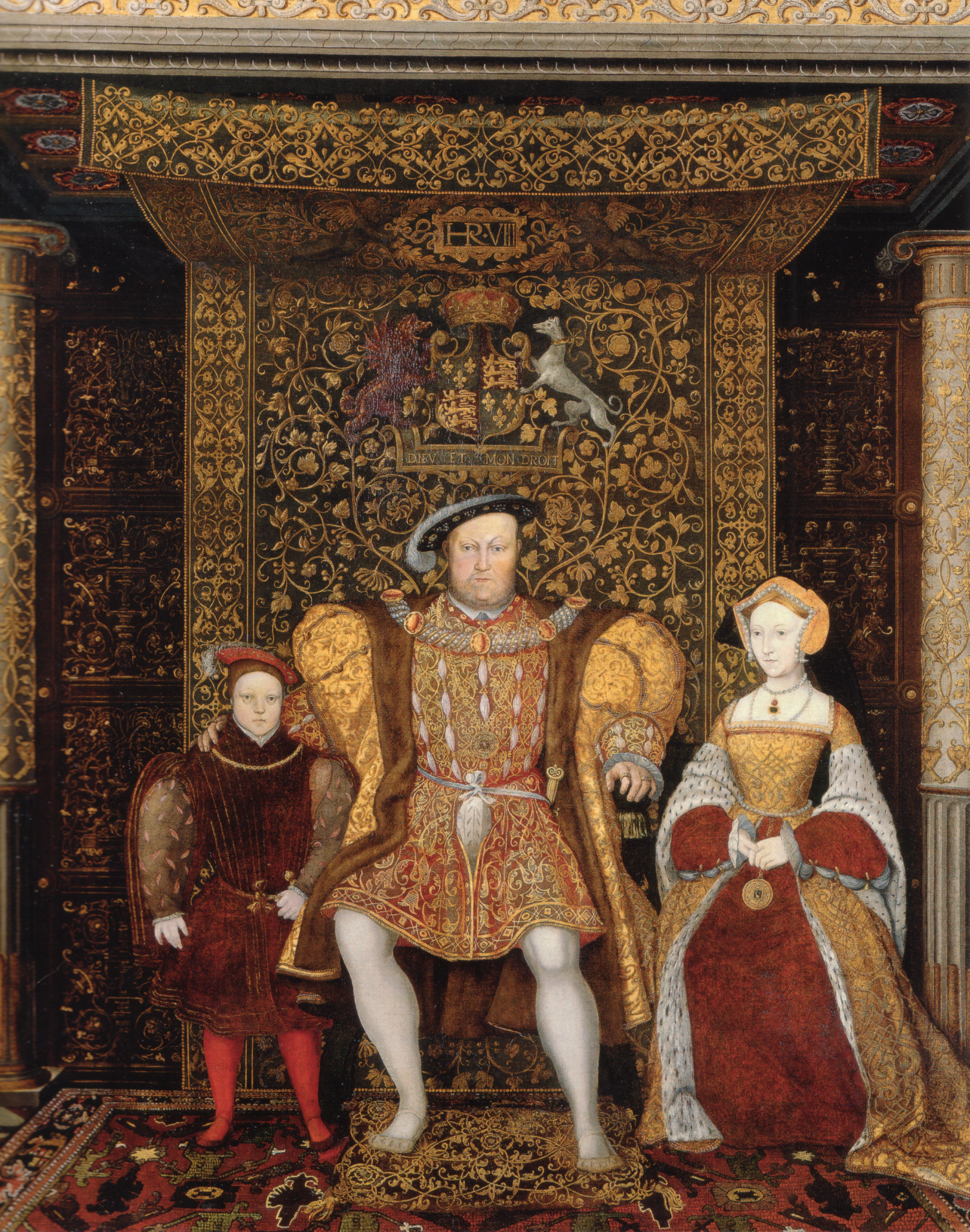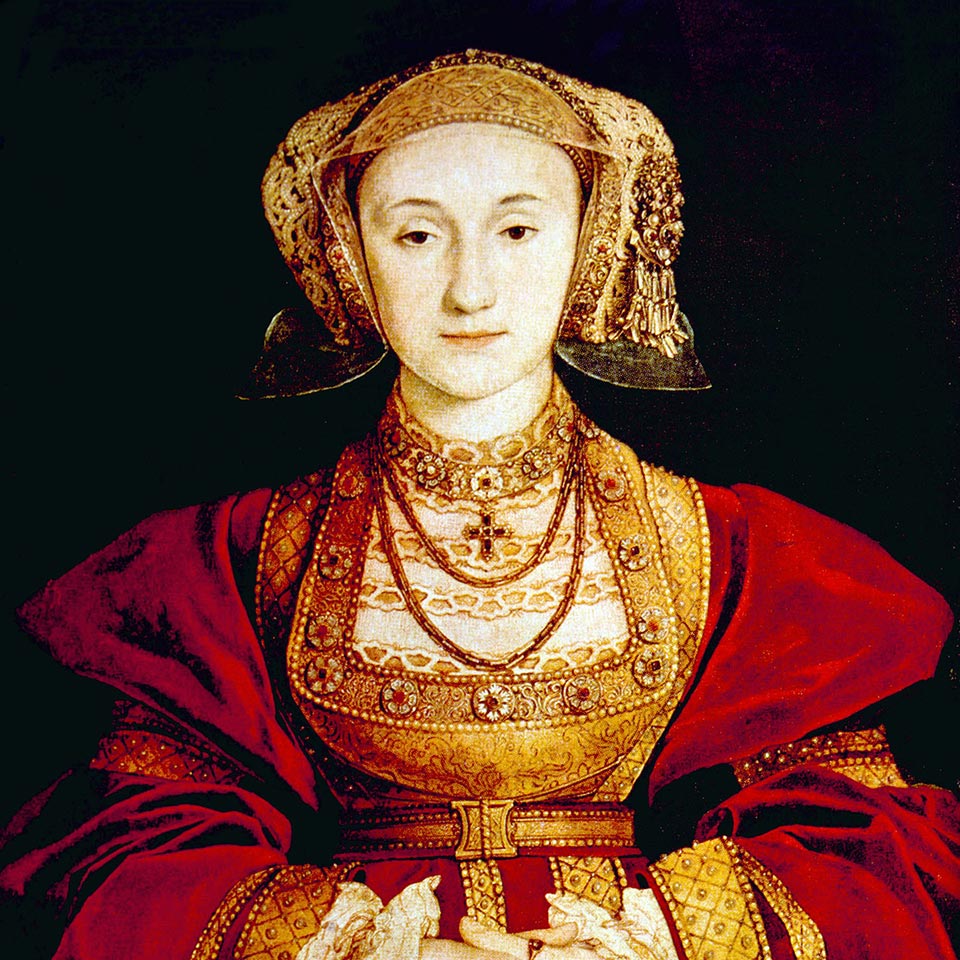King Henry VIII's relentless quest for a male heir led him on a rollercoaster ride of six marriages during his reign. In this article, we unravel the distinct story of each wife - from the divorced to the beheaded to the survivors - in Henry VIII's quest to secure the Tudor line.
Jump to:

Who was Henry VIII?
King Henry VIII was the King of England from 1509 to 1547 and still stands as one of the most iconic figures in English history. Despite his political influence and religious transformation of the English church, it was his insatiable desire for a male heir and his 6 marriages that defined much of his reign and legacy.
Catherine of Aragon - Divorced
Only 6 weeks after Henry VIII ascended the throne in 1509, he married his first wife, Catherine of Aragon, who was a Spanish princess and widow of Henry’s older brother Arthur. During their early years together as a married couple, they seemed to have genuine affection for each other. However, this sadly didn’t last for very long. The main challenge that plagued their marriage was Catherine’s inability to produce a male heir. She gave birth to several children, but only one survived infancy, Princess Mary (born in 1516).
His desperation for a male heir made him impatient, and by the 1520s he had an affair with one of Catherine’s ladies-in-waiting - Anne Boyeln. Henry reached out to the Pope for approval to get his marriage to Catherine of Aragon annulled, but the Pope refused. He then divorced Catherine, which went against the Pope and the Catholic Church. This had huge repercussions and ultimately led to the English Reformation, with Henry putting himself in charge of the new Church of England. This separation from Rome forever changed England’s trajectory - religion and politics would now solely revolve around the monarch’s wishes, rather than the Pope.
Despite being sent away and pressured from all sides, Catherine stood firm in defending their marriage's legitimacy. Even after eventually losing her title and position, she endured public shaming and personal betrayals without compromising her beliefs. She became a symbol of resilience and died as a princess at Kimbolton Castle on January 7th 1536.
Recommended for you!
Best SellersAnne Boleyn - Beheaded
In 1533 when Henry VIII officially divorced Catherine of Aragon, Anne Boylen was crowned queen. As well as his wife, she became the driving force behind the English Reformation. Unfortunately, her time as queen was short lived. Although she gave Henry a daughter, Princess Elizabeth in 1533, her failure to produce a male heir was a critical factor in her decline and she had a series of miscarriages and stillbirths at a time where Henry was trying to secure the Tudor Dynasty.
Her downfall wasn’t purely due to her struggles to reproduce; she had a strong and assertive personality. This was initially one of the reasons Henry was drawn to her, but over time - as she became more assertive and influential - rivals in court started to see her as a threat and became increasingly critical of her. In 1536, Anne Boyeln was accused of adultery and incest by a former ally Thomas Cromwell (likely a politically motivated plot against her). She went to trial and faced a court with no hope for a fair verdict. On May 19 1536, Anne was found guilty of the charges and her execution was scheduled for the next day. She met her untimely death with courage and dignity and her passing was mourned across the country. To this day, historians are not fully convinced that Anne was guilty.
Jane Seymour - Died
Just weeks after Anne Boyelyn’s execution, Henry VIII married Jane Seymour, who was one of Anne’s ladies-in-waiting. She had a modest and humble manner which was quite different from the stronger personalities held by his previous wives. Jane’s most notable achievement was providing Henry VIII with a male heir. In October 1537, she gave birth to a healthy son, Edward VI. As expected, the birth of Edward VI called for celebrations across the kingdom and, more importantly, it solidified the future of the Tudor dynasty. During her time as queen, Jane also played an important role in restoring Princess Anne (Catherine of Aragon’s daughter) to the royal line of succession.
However, Jane Seymour’s reign ended on a more sombre note. On October 12 1537, just days after giving birth to Edward VI, she suffered postnatal complications and tragically passed away. Her death marked the first first instance of a reigning queen of England dying in childbirth. Her legacy continued on through her son, who would go on to become a significant figure in English history himself and the Protestant Reformation.

Anne of Cleves - Divorced
Anne of Cleves was Henry VIII’s fourth wife. In 1539, Henry was eager to secure an alliance with the Duchy of Cleves, and Anne - who was the sister of the Duke of Cleves - was chosen as Henry’s bride as part of this strategic union. She came to England from Germany in 1539. However, when he met Anne of Cleves Henry was disappointed in her appearance (to say the least!). They married in January 1940, but they never consummated their marriage and only 6 months later Henry VIII asked for an annulment. Anne agreed to the annulment and unusually was granted a generous settlement and declared “sister” to the kin - a title which allowed her to maintain her dignity.
Although now divorced, both Anne and Henry maintained an amicable relationship. She was a respected figure at the English court and had a calm, pragmatic approach to life. She even supported his marriage to his fifth wife, Catherine Howard, and attended their wedding. Anne went on to outlive all of Henry VIII’s wives, and even Henry himself and his son, Edward VI.
Catherine Howard - Beheaded
Catherine Howard was a young lady-in-waiting and Henry VIII’s fifth wife. They married in 1540 despite having a significant age gap, as she was only in her late teens and Henry was forty-nine years old. Within the first year of their marriage, there were rumours that Catherine had romantic relationships with multiple courtiers, including her cousin Thomas Culpeper. In 1541, the allegations against Catherine came to light, which prompted an investigation. Even though the full extent of her involvement with other men is unknown, Catherine Howard was arrested, tried, and found guilty of adultery. On February 13th 1542, she endured a similar fate to her cousin, Anne Boyelyn and was executed just two years after her marriage to Henry.
The scandal and her behaviour brought disgrace upon Henry and his court, and some started to question the stability of the Tudor Dynasty since Catherine hadn’t provided another male heir to the throne. However, fingers weren’t always pointed at Henry’s spouses, as the fall of yet another queen revealed the weakness of Henry’s marital decisions. There was a growing sense of unease within the court and abroad, and Henry VIII’s personal life became a matter of interest and public scandal.
Catherine Parr - Survived
In 1543, Catherine Parr became the sixth and last wife of King Henry VIII. Unlike her predecessors, Catherine was a widow, and had been married twice before. She was known for her kind and nurturing personality and quickly established herself as a loving stepmother to Henry's children, particularly Princess Mary and Princess Elizabeth. She also played a part in reconciling Henry with his daughter Princess Mary, and promoted the education of his younger children (including Prince Edward).
In 1547, Catherine Parr published a three-part book called “"The Lamentation of a Sinner," that expressed her Protestant learnings and her concern for the spiritual welfare of her subjects. This was one of the first English-language books written by a queen. She is the only one of Henry VIII’s wives to have “survived”. In that same year, Henry VIII died due to ill health and a leg wound from a jousting accident. She outlived him and went on to marry Thomas Seymour, the brother of Henry’s third wife, Jane Seymour.
She died in 1548, just a year after her third marriage due to complications following the birth of her only child, Mary.
If you've been captivated by the stories of these remarkable women and the era in which they lived, consider enrolling on our online course, “The Wives of Henry VIII”. For just £29 (save £118!), you can explore their lives and legacies in even greater detail. If you’re after an even broader understanding of the Tudor period itself, you could alternatively check out our Tudor History Diploma Course and learn about the most forceful and fascinating royal families in British History.












